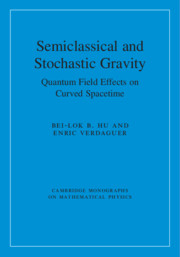Book contents
- Frontmatter
- Dedication
- Contents
- Preface
- 1 Overview: Main Themes. Key Issues. Reader’s Guide
- Part I Effective Action and Regularization, Stress Tensor and Fluctuations
- Part II Infrared Behavior, 2PI, I/N, Backreaction and Semiclassical Gravity
- Part III Stochastic Gravity
- Part IV Cosmological and Black Hole Backreaction with Fluctuations
- 12 Cosmological Backreaction with Fluctuations
- 13 Structure Formation in the Early Universe
- 14 Black Hole Backreaction and Fluctuations
- Part V Quantum Curvature Fluctuations in de Sitter Spacetime
- References
- Index
12 - Cosmological Backreaction with Fluctuations
from Part IV - Cosmological and Black Hole Backreaction with Fluctuations
Published online by Cambridge University Press: 20 January 2020
- Frontmatter
- Dedication
- Contents
- Preface
- 1 Overview: Main Themes. Key Issues. Reader’s Guide
- Part I Effective Action and Regularization, Stress Tensor and Fluctuations
- Part II Infrared Behavior, 2PI, I/N, Backreaction and Semiclassical Gravity
- Part III Stochastic Gravity
- Part IV Cosmological and Black Hole Backreaction with Fluctuations
- 12 Cosmological Backreaction with Fluctuations
- 13 Structure Formation in the Early Universe
- 14 Black Hole Backreaction and Fluctuations
- Part V Quantum Curvature Fluctuations in de Sitter Spacetime
- References
- Index
Summary
As a second application of stochastic gravity, we discuss in this chapter the backreaction problem in cosmology when the gravitational field couples to a quantum conformal matter field, and derive the Einstein–Langevin equations describing the metric fluctuations on the cosmological background. Conformal matter may be a reasonable assumption, because matter fields in the standard model of particle physics are expected to become effectively conformally invariant in the very early universe. We consider a weakly perturbed spatially flat Friedman–Lemaitre–Robertson–Walker spacetime and derive the Einstein–Langevin equation for the metric perturbations off this spacetime, using the CTP functional formalism described in previous chapters. With this calculation we also obtain the probability for particle creation. The CTP effective action is also used to derive the renormalized expectation value of the quantum stress-energy tensor and the corresponding semiclassical Einstein equation.
Keywords
- Type
- Chapter
- Information
- Semiclassical and Stochastic GravityQuantum Field Effects on Curved Spacetime, pp. 391 - 409Publisher: Cambridge University PressPrint publication year: 2020

